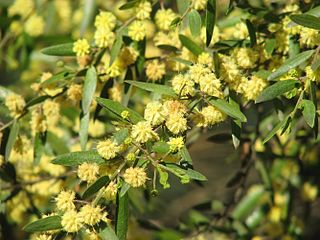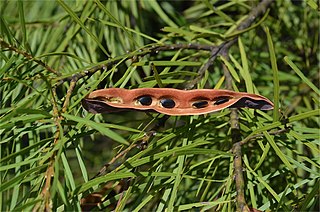
Acacia pycnantha, most commonly known as the golden wattle, is a tree of the family Fabaceae. It grows to a height of 8 metres and has phyllodes instead of true leaves. The profuse fragrant, golden flowers appear in late winter and spring, followed by long seed pods. Explorer Thomas Mitchell collected the type specimen, from which George Bentham wrote the species description in 1842. The species is native to southeastern Australia as an understorey plant in eucalyptus forest. Plants are cross-pollinated by several species of honeyeater and thornbill, which visit nectaries on the phyllodes and brush against flowers, transferring pollen between them.

Acacia acanthoclada, commonly known as harrow wattle, is a species of flowering plant in the family Fabaceae and is endemic to southern continental Australia. It is a low, highly branched, spreading and spiny shrub with wedge-shaped to triangular or egg-shaped phyllodes with the narrower end towards the base, and spherical heads of up to 30 flowers, and linear, spirally-coiled pods.

Acacia enterocarpa, commonly known as jumping jack wattle, is a shrub species that is endemic to eastern Australia.

Acacia genistifolia, commonly known as spreading wattle or early wattle is a species of Acacia in the family Fabaceae that is native to south eastern Australia.

Acacia brownii, commonly known as heath wattle, is an erect or spreading shrub which is endemic to eastern Australia.

Acacia decora is a plant native to eastern Australia. Common names include the western silver wattle and the showy wattle. The species name refers to the plant's decorative qualities.

Acacia verniciflua, commonly known as varnish wattle, is a shrub or small tree species that is endemic to Australia. The species occurs in dry sclerophyll forest in South Australia, Victoria, New South Wales and Queensland. It is often found growing alongside Eucalyptus obliqua where it can dominate the understory.

Acacia howittii, commonly known as sticky wattle or Howitt's wattle, is a tree species that is endemic to Victoria, Australia.

Acacia lanigera, commonly known as woolly wattle or hairy wattle, is a tree species that is endemic south eastern Australia.

Acacia buxifolia, commonly known as box-leaf wattle, is shrub species that is endemic to eastern Australia.

Acacia mitchellii, commonly known as Mitchell's wattle, is an erect or spreading shrub which is endemic to Australia. It grows to up to 2 metres high and has small bipinnate leaves. The pale yellow globular flowerheads appear in groups of 1 to 3 in the axils of the phyllodes followed by straight or curved seed pods which are 1.8 to 5 cm long and 4 to 8 mm wide.

Acacia aspera, commonly known as rough wattle, is a spreading shrub which is endemic to south-eastern Australia. It grows to up to 2 metres high and has phyllodes which are 10 to 30 mm long and 2 –4 mm wide. The pale yellow to gold globular flowerheads appear singly or in groups of two in the axils of the phyllodes in July to September, followed by curved or coiled seed pods which are 20 to 70 mm long and 3 to 5 mm wide.

Acacia gunnii, commonly known as ploughshare wattle or dog's tooth wattle, is a woody shrub which is endemic to south-eastern Australia found in dry heaths and woodlands. It ranges from Queensland, then New South Wales, Australian Capital Territory, Victoria, South Australia, down to Tasmania. Acacia gunnii grows to up to 1 metre high and has prickly phyllodes which are 4 to 15 mm long. The cream to pale yellow globular flowerheads appear singly in the axils of the phyllodes in June to October, followed by curved or coiled seed pods which are 40 mm long and 4 to 5 mm wide. Acacia gunnii grows up to 1 meter tall and has prickly phyllodes which are 4 to 15mm in length with cream to pale-yellow globular flower heads appearing in phyllode axils in June through to October, followed by curved or coiled seed pods which are 40mm long and 4 to 5 mm wide. The species was first formally described by English botanist George Bentham in the London Journal of Botany in 1842. It occurs in South Australia, Victoria, Tasmania, New South Wales, Australian Capital Territory, and Queensland.

Acacia rigens, commonly known as nealie, is an erect or spreading shrub or small tree that is endemic to Australia. Other common names include needle wattle, needlebush acacia, nealia and nilyah.

Acacia prominens is a shrub or tree in the genus Acacia native to New South Wales, Australia.

Acacia cognata, commonly known as bower wattle, river wattle or narrow-leaved bower wattle, is a tree or shrub species that is endemic to south eastern Australia.

Acacia ausfeldii, commonly known as Ausfeld's wattle or whipstick cinnamon wattle, is a shrub species that is endemic to south-eastern Australia. It grows to between 1 and 4 metres high and has phyllodes that are 2 to 7 cm long and 2 to 6 mm wide. The yellow globular flowerheads appear in groups of two or three in the axils of the phyllodes in August to October, followed by straight seed pods which are 4 to 9 cm long and 2 to 4 mm wide.

Acacia caerulescens, commonly known as limestone blue wattle, Buchan blue or Buchan blue wattle is a tree species that is endemic to south eastern Australia.

Acacia bynoeana, known colloquially as Bynoe's wattle or tiny wattle, is a species of Acacia native to eastern Australia. It is listed as endangered in New South Wales and as vulnerable according to the Environment Protection and Biodiversity Conservation Act 1999.

Acacia macnuttiana, commonly known as McNutt's wattle, is a flowering plant in the family Fabaceae and is endemic to north-eastern New South Wales. It is a shrub with linear phyllodes, spherical heads of bright yellow flowers arranged in racemes in leaf axils and seeds usually in more or less straight, leathery pods.























